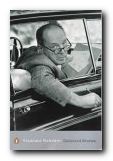a critical examination of Nabokov’s collected stories
 In ‘The Thunderstorm’ (July 1924), Nabokov took as his central idea the Russian folk belief that the Old Testament prophet Elijah rode his chariot in the sky during thunderstorms. He pushed the element of narrative ambiguity to a point which makes it difficult for the reader to understand exactly what has happened in any realistic sense. This particular type of ambiguity, and the fact that the story involves a character from the Bible, are features which Nabokov did not repeat in any of his subsequent stories.
In ‘The Thunderstorm’ (July 1924), Nabokov took as his central idea the Russian folk belief that the Old Testament prophet Elijah rode his chariot in the sky during thunderstorms. He pushed the element of narrative ambiguity to a point which makes it difficult for the reader to understand exactly what has happened in any realistic sense. This particular type of ambiguity, and the fact that the story involves a character from the Bible, are features which Nabokov did not repeat in any of his subsequent stories.
A first person narrator called Elisha, speaking to an unnamed ‘you’, describes a gathering storm one night in west Berlin. The wind, which he personifies as ‘a blind phantom, covering his face with his sleeves’ (DS,p.119) develops into a full blown storm – ‘a white-haired giant with a furious beard’ (p.120).
But then this giant, the prophet Elijah, loses a wheel of his chariot and on falling to earth asks Elisha to help him find it. Elisha locates a rusty pram wheel amongst a pile of rubbish in the courtyard, whereupon Elijah re-ascends into the heavens and Elisha rushes off into the dawn to tell his story to the unknown ‘you’.
Obviously we are being invited to read the whole incident as a product of Elisha’s excited mind. The reader has every reason to think that this is an imaginary episode. Immediately before the incident Elisha falls asleep, and just before the prophet departs Elisha closes his eyes, reopening them to find the courtyard empty.
This is a conventional device for suggesting that the events in between have taken place in the narrator’s imagination whilst asleep. But if this is the case the fabrication rests at the level of mere fantasy: it is not shown in relationship to anything else, and it does not tell us anything about the narrator.
There is a curious correspondence between the two figures which might lead us to expect a further variation on the theme of the double. Quite apart from the similarity of their names, they are dressed in the same clothes. Elijah wears a ‘drenched robe and sandals’ (p.122), and Elisha has ‘soaked bedslippers and a worn dressing gown’ (p.123). But we are given no further information to make sense of these clues.
What the story seems to be is an early, not so successful exercise in the incorporation of Gogolian influence. For certain elements of Gogol are strongly present. A dreamy Elisha runs into the street in his ‘bedslippers and worn dressing gown’ (p.123) so much like one of the petty clerks of Gogol’s tales. The story is an ‘as if’ fantasy, built upon the sort of unrealities which characterise ‘The Nose’.
And Elijah in ‘his fiery chariot, restraining with tensed arms his jet-black steeds…[which] tossed their blazing manes and rushed on ever more violently, down, down along the clouds’ (p.120) recalls vividly the poor clerk invoking an imaginary troika at the desperate close of Diary of a Madman: ‘Give me a troika with horses swift as the whirlwind! Climb up, driver, and let the bells ring! Soar away, horses, and carry me from this world!’
We might also note here, en passant, two of Gogols stylistic devices much used by Nabokov: the narrator addressing his own fictional creations (the coachman, the horses) and his use of semantic parallelism (“Drive on…Soar upward”).
It is not a particularly convincing blend of realism and fantasy, but viewed in the context of the other stories he was writing at this time (to say nothing of the poetry, plays, and theatre sketches) it seems quite clear that Nabokov was casting round and experimenting until he found that approach to narrative which suited him best. As Brian Boyd observes, a propos of Nabokov’s interest in different levels of reality, he was ‘still searching for ways to fit a world beyond into the world of the human, but he had not found his own way yet.’
© Roy Johnson 2005
![]() Vladimir Nabokov: The Collected Stories – Amazon UK
Vladimir Nabokov: The Collected Stories – Amazon UK
![]() Vladimir Nabokov: The Collected Stories – Amazon US
Vladimir Nabokov: The Collected Stories – Amazon US
Vladimir Nabokov web links
Vladimir Nabokov greatest works
Vladimir Nabokov criticism
Vladimir Nabokov life and works